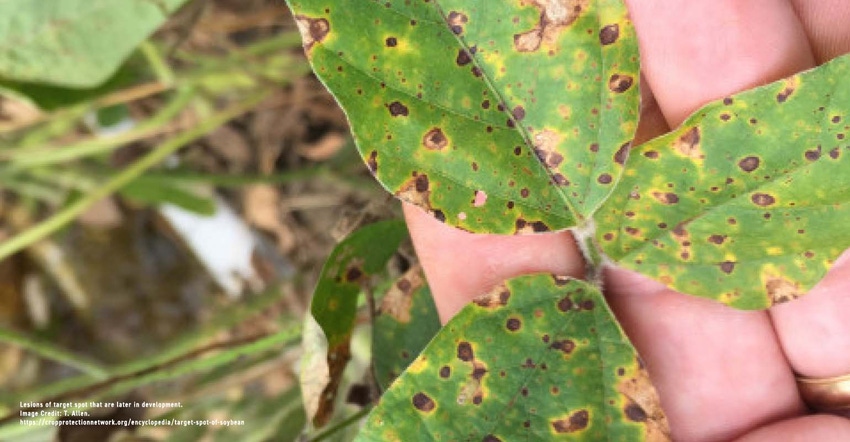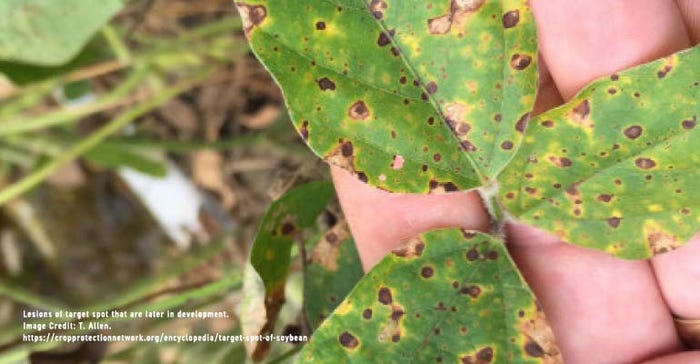June 1, 2022

Sponsored Content
Target Spot is a soybean disease caused by the Corynespora cassiicola fungi. Before 2010 it would have been considered a minor disease in soybeans in the Mid-South and Southeast regions of the United States. However, detection of the pathogen has significantly increased in recent years. Many would argue that it is one of the more prevalent diseases observed in soybeans in the South and in cotton fields. Susceptible cultivars can experience yield losses of up to 18 to 32% when favorable conditions are present but rarely result in significant yield losses in the Mid-South.
Disease Cycle and Field Conditions
The Target Spot pathogen overwinters on infected crop residue. The environmental conditions favorable for initial infections include high humidity (greater than 80%) and warmer temperatures within the crop canopy (75 to 85°F). In the Mid-South, infection instances increase throughout July and August if prolonged wet periods occur. When infection of this pathogen occurs, it is not acting alone. Other diseases like Septoria Brown Spot or Pod and Stem Blight tend to occur under the same conditions, in the same field, and in the same part of the soybean canopy. Target Spot can also be combined in the presence of diseases like Frogeye Leaf Spot.

Symptomology
Target Spot is a foliar pathogen that will generally be more prevalent in the lower to mid-canopy. It will appear as reddishbrown lesions, irregularly shaped, and will sometimes appear to have an angular border with a yellow halo surrounding the lesion. Not only do the lesions vary in shape, but they also vary in size, depending upon where they are found on the plant, with smaller lesions being found in the upper canopy. Overall, the diameter of the lesions will stay between 3/8 to 5/8 inches. Reflective of the name, there will be concentric rings within more mature/developed lesions. According to Crop Protection Network, lesions are often not observed until canopy closure later in the growing season. Target Spot is not only a foliar pathogen; it can also be observed on petioles and stems, appearing as dark brown lesions that vary in size from specks to elongated dark areas. Lesions are less common on pods. Lesions on pods are observed as small, circular purple or black spots with brown margins.

Disease Management
Cultural Practices
The type of irrigation method used influences the disease occurrence in cotton. In the delta regions of Arkansas and Mississippi, the primary irrigation method in cotton is furrow irrigation. In the Southeast region of the United States, where Target Spot instances are greater, cotton is typically planted in narrow row patterns and irrigated via overhead irrigation. This is due to the moisture present within the mid-and lower canopy.
The same can be said for soybeans. Disease presence can be reduced by decreasing the moisture present within the canopy and changing the environmental conditions. Other means of managing Target Spot are managing infected crop residues and avoiding soybean monoculture without using a fungicide for protection against Target Spot.
Resistance
Many commercially available soybean varieties exhibit some level of susceptibility to Target Spot. However, there is no known resistance to this disease.
Fungicides
With limited assistance from variety tolerance, fungicides become the primary mechanism for managing Target Spot. Studies conducted in Stoneville, MS, suggest that fungicides have reduced severe defoliation in the middle canopy. However, target spot instances were not eliminated by using a fungicide. Stoneville, MS, trial data resulted in maintaining between 2 to 8% defoliation in the middle canopy compared to approximately 60% defoliation in the untreated plots. Yield advantages of 4.9 Bu./A. were observed in 2017 by using a fungicide (triazole + SDHI) compared to the untreated plots.
Beck's - Farmers At Heart® - revolutionized the customer seed buying experience by remaining true to a foundation built on faith, family, and farming. Founded in 1937, Beck's appreciates the farmers who have helped them become the largest family-owned retail seed company and the third largest seed brand in the United States. The Beck family is now in its fifth generation of family members who work in the business to honor God and help farmers succeed. The Beck family and team of employees help farmers achieve success from generation to generation through authentic customer experiences, product diversity, seed quality, and performance. With a home office located in Atlanta, Ind., Beck's serves farmers throughout the Midwest and Mid-South. For more information about Beck's Superior Hybrids, Inc., visit www.beckshybrids.com.
About the Author(s)
You May Also Like




